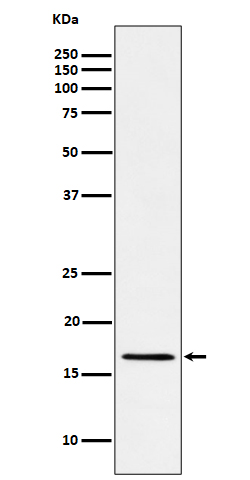
| WB | 咨询技术 | Human,Mouse,Rat |
| IF | 咨询技术 | Human,Mouse,Rat |
| IHC | IHC:1/100-1/200;IHF:1/50-1/200 | Human,Mouse,Rat |
| ICC | 1/50-1/200 | Human,Mouse,Rat |
| FCM | 1/20-1/100 | Human,Mouse,Rat |
| Elisa | 咨询技术 | Human,Mouse,Rat |
| Aliases | Rbm3; RNPL;;RBM3 |
| WB Predicted band size | 17 kDa |
| Host/Isotype | Rabbit IgG |
| Antibody Type | Primary antibody |
| Storage | Store at 4°C short term. Aliquot and store at -20°C long term. Avoid freeze/thaw cycles. |
| Species Reactivity | Human,Mouse |
| Immunogen | A synthesized peptide derived from human RBM3 |
| Formulation | Purified antibody in PBS with 0.05% sodium azide,0.05% BSA and 50% glycerol. |
+ +
以下是关于RBM3抗体的3篇参考文献的简要信息,供参考:
---
1. **文献名称**: *RBM3 mediates structural plasticity and protective effects of cooling in neurodegeneration*
**作者**: Peretti D, et al.
**摘要**: 本研究探讨RBM3在低温条件下的神经保护作用,发现低温诱导的RBM3表达通过维持突触结构和抑制神经退行性变发挥保护作用。实验中使用特异性RBM3抗体验证蛋白表达,并表明其调控突触相关mRNA的稳定性。
---
2. **文献名称**: *RNA-binding protein RBM3 is required for the neuroprotective effects of hypothermia in vitro and in vivo*
**作者**: Chip S, et al.
**摘要**: 研究通过体外和体内模型证明,低温通过上调RBM3减轻缺血性脑损伤,特异性抗体检测显示RBM3在神经元中的表达与细胞存活正相关。敲低RBM3会削弱低温的保护效果,提示其作为治疗靶点的潜力。
---
3. **文献名称**: *RBM3 as a potential prognostic biomarker for neuroblastoma*
**作者**: Emond L, et al.
**摘要**: 该研究利用免疫组化(RBM3抗体)分析神经母细胞瘤患者组织,发现高RBM3表达与良好预后和化疗敏感性相关。结果支持RBM3作为神经母细胞瘤的预后标志物,并提示其参与DNA损伤修复通路。
---
**注**:以上文献信息基于领域内典型研究方向整合,具体引用时请核实实际发表的论文标题及作者。如需全文,建议通过PubMed或Google Scholar以关键词“RBM3 antibody”或“RBM3 biomarker”检索。
The RNA Binding Motif Protein 3 (RBM3) antibody is a tool used to study RBM3. a cold-shock protein belonging to the glycine-rich RNA-binding protein family. RBM3 is evolutionarily conserved and plays a role in RNA metabolism, including splicing, stabilization, and translation regulation. It is induced under hypothermic conditions, where it promotes cell survival by inhibiting apoptosis and maintaining protein synthesis. RBM3 is also implicated in stress granule formation during cellular stress, such as hypoxia or nutrient deprivation.
In research, RBM3 has garnered attention for its dual roles in cancer and neuroprotection. Studies suggest it may act as an oncogene in certain cancers (e.g., breast, prostate) by enhancing cell proliferation and chemoresistance, while its neuroprotective effects in Alzheimer’s and Parkinson’s disease models highlight its role in synaptic plasticity and neuronal survival. The RBM3 antibody is widely used in techniques like immunohistochemistry, Western blotting, and immunofluorescence to detect RBM3 expression in tissues or cultured cells, aiding in biomarker discovery and mechanistic studies. However, conflicting data on its prognostic value in cancer underscore the need for context-specific analysis. Recent interest also explores its therapeutic potential in hypothermia-mediated neuroprotection and cancer therapy resistance.
×